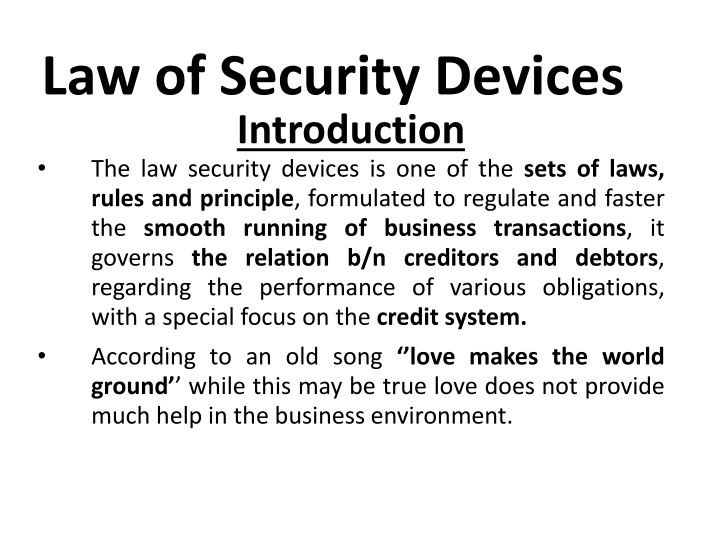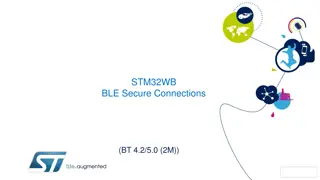
Introduction to Law of Security Devices in Business Transactions
The law of security devices is essential for regulating business transactions, focusing on the relationship between creditors and debtors. This set of laws ensures the smooth performance of various obligations within the credit system. Learn about securities, collateral, and creditor protection in commercial dealings. Explore the significance of security contracts and the role they play in economic communities.
Uploaded on | 0 Views
Download Presentation

Please find below an Image/Link to download the presentation.
The content on the website is provided AS IS for your information and personal use only. It may not be sold, licensed, or shared on other websites without obtaining consent from the author. If you encounter any issues during the download, it is possible that the publisher has removed the file from their server.
You are allowed to download the files provided on this website for personal or commercial use, subject to the condition that they are used lawfully. All files are the property of their respective owners.
The content on the website is provided AS IS for your information and personal use only. It may not be sold, licensed, or shared on other websites without obtaining consent from the author.
E N D
Presentation Transcript
Law of Security Devices Introduction The law security devices is one of the sets of laws, rules and principle, formulated to regulate and faster the smooth running of business transactions, it governs the relation b/n creditors and debtors, regarding the performance of various obligations, with a special focus on the credit system. According to an old song love makes the world ground while this may be true love does not provide much help in the business environment.
Intro Cont. . I deed from a business perspective credit may be what makes the business world go round (Source:- Davidson Knowles, business law principle and cases in the legal environment) -The grand objective of law of security device is to facilitate the smooth running of commercial transactions w/c are indispensable for the creation of one economic community. In the strict sense of the term security refers to either personal security(surety) or property securities - pledge and mortgage.
Intro Cont. . In the broad sense of the term Antichresis special type of mortgage, lien rights, rights of redemption also possess securities. the nature of As to law of security devices is based on special contracts and the general principles and guidelines from the provisions of contract in general are applicable.
CHAPTER General Introductory issues 1.1 Definition of securities. ONE Blacks law dictionary provides that security is 1) Collateral given or pledged to guarantee the fulfillment of an obligation, esp, the assurance that (USu with interest) any money credit extended to a debtor. a creditor will be repaid 2) A person who is bound by some type of guaranty person who is primarily liable for the surety (A payment of an others obligation).
General Intro. Cont. . In his treatise an civil law the M. Pilaniol-also provides definition of security contracts as those contracts intended to protect creditor against the insolvency of the debtor. Insolvency is the state of debtor whose liabilities are greater than his assets . Points from the above definitions. 1) Security is an undertaking to assure / guarantee the creditor that the debt will be paid or the obligation will be performed to the satisfaction of the creditor.
General Intro. Cont. . 2) It is also providing the creditor with alternative remedy in case the debtor fails to pay the debt to fulfill his obligation. 3. Security created principally for the benefit of the creditor, however, the debtor also many be considered to have at least indirect benefit (e.g getting loan easily 4) Security arise, most of the time, from contract b/n the creditor and the debtor or 3rdparty. 5) Security can exist only if there is a debt to be paid or obligation to be performed.
1.2 From the very purpose for the creation of security, they are designed to facilitate the relations b/n creditor and debtor. Securities play a great role in smoothening the relation b/n creditor and debtor how? It is by assuring the creditor that the debtor will pay or discharge his obligation, then the security rights of the creditor will be enforced to satisfy the claim of the creditor. This substantially reduces, if not avoid, the possible damage and inconveniences w/c may ensure from the non-performance by the debtor. Importance of Securities.
Importance Cont. . The importance of securities is not only for the creditor but also for the debtor and even the society in generally. From the debtor s angle, the debtor who offers security will have better access to loan than a debtor who requests creditor a credit with-out offering any security. From the societies angle, Business activities specially in developing countries are financed through loan system. It assists business activities.
1.3 Nature of Securities The most important distinguishing character of securities is that securities by their nature are accessory or secondary rights. Accessory rights are those rights the existence of which is conditioned up on valid existence of another rights referred to as primary rights. Rights in general are referred to as accessory if they don t have independent existence or if they are not created for their own sake.
Nature Cont. .. The division of certain rights as principal (primary) and the others as secondary (accessory) indicates that the former groups of rights is enforceable by themselves independently while the enforceability of the later groups depends on the failure to enforce the principal rights. Therefore, primary rights are available for the owner of the right and enforceable for their own sake while accessary rights are made available merely in substitution for the primary rights the existence of w/c has failed for various reasons.
Nature Cont. . There would be no reason for securities to exist unless there is primary obligation the performance of w/c is ensured by creating security right. Accordingly, securities are accessory as they cannot exist or cannot enforce in the absence of principal rights/ obligations. Generally, securities are created as an alternative remedy for the creditor in case the debtor fails to perform the principal obligation
Nature Cont. . This accessory nature of securities can be seen from various angles. 1st without valid obligation no securities can exist 2nd the enforcement of securities is conditioned up on the failure of the debtor to discharge his obligation. - Securities can be enforced only after ascertaining the failure of the debtor. To ascertain the failure of the debtor we need to wait for the due date of the principal obligation. Hence, securities stay inactive until the due date of the secured obligation. - - 3rdly ifthe primary obligation is extinguished for what so ever reason, it automatically results in the extinction of securities.
Nature Cont. . In conclusion, -the creation of securities, whatever its type may be, presumes the existence of a valid obligation w/c the creditor expects to be performed, -the execution of securities presumes the failure of the debtor to discharge his obligation -a reason w/c brings about extinction of primary obligation at the same time result in the extinction of securities.
1.4 Types of Securities Depending on their nature, content and effects securities are classified in different forms in different legal systems. The classification adopted our legal system; there are two types of securities. These are:- 1) Personal security 2) Real (property) 1) Personal security:- is also referred to a surety. This is the type of security in which case the security right of the creditor is against human person called guarantor.
Types of securities Cont. The guarantor undertakes, in terms of money, towards the creditor, to perform the primary obligation in case the debtor fails to perform it. Another important point here is that personal security (surety) is a part of contracts in generally since the relevant provisions of surety(1920-1952 ) are found in the part of civil code dealing with general contracts. (Please refer the course Law of contract) Here, Do not forget that surety is one of the actively working type of security in day to day business transaction. What is more, some of the provisions of surety ship are highly relevant in the functioning of other securities (real securities) read art 1920-1952 ECC.
Types of securities Cont. 2. Real(Property) Security- is the case where the security right of the creditor is against property or a thing. Under this type of security the right of the creditor will be enforced against the thing on which he claims to have security right. Real security, in turn are classified in to two These are - 1) Pledge 2) Mortgage
Types of securities Cont. 1) Pledge: - is security against movable which is referred to as pledge in many legal system including ours But also called as pawn, bailment etc. in other legal systems. 2) Mortgage:- is the case where the security is created against immovable principally. It is called Mortgage in most of legal systems. - Mortgage may sometimes, change to another form of security i.e. Antichresis, if there is a special arrangement b/n the creditor and the debtor.
Types of securities Cont. Antichresis, is therefore, a special mortgage An important point that the above classification does not automatically exclude other types of rights which may, in certain circumstances, be considered as securities. The principal examples of such rights may be- Lien rights, Sale with ownership reserved, Rights of redemption and others. type of
CHAPTER TWO Pledge (Security on movables) 2.1 Definition of pledge The definition of pledge has gone through a long process of development which has contributed to the refinement of the definition of pledge and its elements. However, common understanding and uniform definition of pledge seems to be still lacking. This is true because for one legal system pledge is simply a specially type of bailment, while it is a lien right for the other legal system
Definition cont. . Read the following definition of pledge taken from books and identify the basic elements and points from, Black s law Dictionary 8thed 2004 Pledge is a security interest in personal property represented by an indispensable instrument, the interest being created by a bailment or other deposit of personal property for the purpose of securing the payment of debt or the performance of some other duty Merchantile law, 5thed, by Me Kuchhal (1999) The bailment of goods as security for payment of a debt or performance of a promise is called pledge : the bailor in this case is called the pawn or the bailee is called the pawnee
Definition cont. . From Treatise on civil law, Vol II, Part II, by M. Planiol (1939) Pledge is a contract by which the debtor himself or a third person remits to the creditor a movable object to serve him as security. Pledge is a contract at the same time production of obligations and creator of a real right From the elements of jurisprudence, 13thed, by sir Thomas Erskine Holland, k, (2006) Pledge may be defined as a right in rem realizable by sale, given to a creditor by way of accessory security to right in personam. The above definitions, in general, address various aspects of pledge like the purpose of the contract of pledge, the nature of the relation under contract of pledge, the indication about rights and duties of the parties.
Definition cont. . Please answer the following questions. - Who are parties to the contract of pledge? - What kind of objects can be pledged and who can offer the object for pledge? - What is the principal purpose of pledge? - What is the basic nature of contract of pledge? - What basic rights and obligations do you expect to arise from contract of pledge? Now let us look in to the definition of pledge and its various elements under the Ethiopia law of pledge. Art 2825-Definition A contract of pledge is a contract where by a debtor undertakes to deliver a thing called pledge to his creditor as security for performance of an obligation . -
Definition cont. . After reading the provision, following questions? What is the source of pledge, can it arise from provision of law or can it be created by decision of the courts? Who can give an object as a pledge? What is the basic obligation that the pledger has to assume for the contract of pledge to be created validity? What kind of pledge can be delivered as a security under contract of pledge? What is the principal purpose of Concluding contract of pledge? please answer the
Definition cont. . Contract of pledge is:- a) a contract, b) the debtor c) undertakes to deliver d) a thing e) to his creditor f) as security for performance of an obligation. A) Pledge is a contract:- (What is the source of pledge?) Contract of pledge is a contract. This is an important point as it shows that in our legal system, the only source of pledge is contract. In other words, unless there is a clear agreement between the parties with the purpose of creating pledge, there is no way for pledge to exist. It arises only from express contract, which has to fulfill certain requirements of law for its validity. (Illustration- Case 1 and 2) Consider the following components of the definition
Definition cont. . The simple fact that certain property belonging to the debtor falls under the possession of the creditor by chance or for a different purpose does not entitle him to claim security right on the property even if he has lawful claim from the debtor. Because, pledge as a security, may arise only from contract pursuant to art 2825 of the civil code. The mere fact that there is preceding contract of pledge to secure the payment of specified loan does not automatically entitle the creditor to claim security right on the same property for the payment of another loan extended to the same debtor.
Definition cont. . The creditor may be entitled to continue in the possession of the object as security for the second loan only if they vary the existing contract of pledge before the due date of the 1stloan or if they conclude a new contract of pledge to secure the payment of the second loan. In the absence of such arrangements the creditor is duty bound to return the property to the owner up on the discharge of secured obligation and cannot claim security/priority right for the payment of another debt in accordance with art 2845(1) and 2858(2) of the civil code which provide as follows:
Definition cont. . Art 2845 Return of pledge (1)The creditor shall return the pledge to the pledger to the person designated by him if the contract of pledge is extinguished by payment of the debt or for any other reason Art 2858(2) (2) The pledge may not enforce his priority right arising out of the contract of pledge beyond the maximum amount specified therein.
Definition cont. . The pledgee may not enforce his priority right to obtain security for another debt, even if incurred subsequently to the contract of pledge, owned to him by the debtor or pledger. In conclusion, a creditor enjoy a security right as a pledge only if there is a clear contract of pledge which entitles him to this right. Hence, the only source of pledge is contract unlike the case provisions of the law or judgment of courts or arbitral tribunals
Definition cont. . b) ..the debtor ..(Who may deliver the object as a pledge? Who can be a pledger?) As per art 2825 of the civil code, it seems that the appropriate person to deliver the object is the debtor. However, from the fact of the real world as well as the provisions of the law, it is clear that the pledged property may be delivered by either the debtor himself or a non-debtor 3rdparty on behalf of the debtor. (Case 3) Art 2826 a contract of pledge may be made between the creditor and a third party to secure the debt of another person. In general, the point here is that it is not only the definitional article says, but also a third party may deliver the object and be considered as a pledger.
Definition cont. . c) ..undertakes to deliver . From the reading of the above phrase in the definitional article, it is understandable that the basic obligation to be assumed by the pledger in the creation of the a contract of pledge is undertaking to deliver rather than actual delivery, that is for the contract of pledge to come in to existence. Undertaking by the pledger is sufficient. In other words, actual delivery of the object is not precondition to say that a valid contract of pledge has been concluded.
Definition cont. . Actual delivery and immediate transfer of possession is not a requirement under the law. (Case 4) Art 2842- Action for possession (1)The pledgee may bring actions for possession in respect of the pledge. d) .a thing .(What kind of object can be pledged?) Everything, that has an economic and financial value can be pledge because; the definitional article says that a debtor undertakes to deliver a thing.
Definition cont. . A thing refers to everything whether corporeal or incorporeal, movable or immovable, which can be appropriate and put into economic use. Hence, the word thing refers to at least movables and immovable. However, it is not much difficult to understand from other provisions in the law of pledge that it is only movable that can be given as pledge in our legal system. Here , it is also important to note that movables, is understood in its broad sense. That is it refers not to only movable objects but also to various forms of rights and claims on movables.
Definition cont. . Please read Art 2829 1 ) The pledge may consist of a chattel, a totality of effects, a claim or on other right relating to movable property. 2) It must be capable of being sold separately by public auction. From the reading of the above article one may understand that pledge relates to either movable things themselves or claim and rights on movables. Another important point here is that the pledge of movable should be capable of being sold transferred by public auction. For example - objects/properties forming part of a public domain cannot be sold in any way. .
Definition cont. . In conclusion, it is not everything, which can be pledged, but only movable or rights and claims relating to movables w/c are capable of being sold separately. e) .to his creditor . (Who may be the pledged property? possessor of In principle, the pledged property will be delivered to the pledgee - creditor and he is considered as a lawful possessor who can bring even possessory action to protect his possession (see Art 2842(1). However, in some exceptional situations the pledged property may be delivered to a 3rdparty custodian who will keep the thing under his custody on behalf of the pledger and pledge- creditor.
Definition cont. . Article 2931 possession by an agreed 3rdparty 1) The parties may agree that the pledge be delivered to a third party acceptable to them both. 2) The rights and duties of such 3rdparty shall be prescribed by the provisions relating to the bailment of goods and warehousing. f) as a security for the performance of an obligation(the accessary nature of contract of pledge) The contract of pledge may be concluded and the property may be delivered to the creditor as a security for the performance of an obligation.
Definition cont. . This phrase clearly shows that contract of pledge is accessory to some principal obligation which a creditor expects to be performed at a certain date in the future. In other words, the only purpose of pledge is to secure the performance of an obligation. Without the existence of any principal obligation, pledge may not be created for it does not have any other purpose except securing the performance of an obligation. Note - When we say that primary obligation should exist it is not a requirement that the obligation should actually exist on the date of conclusion of the contract of pledge. It may be an obligation, which we are certain to exist in the future.
Definition cont. . Art- 2827 debt guaranteed A contract of pledge may be made in order to guarantee a future or conditional debt . Moreover, pledge is accessary right not only because it presumes the existence of a primary obligation it secures but also it extinguishes if the primary obligation it secures is extinguished by any reason including performance (see art 2845(1) and 2849. In addition, the enforcement/execution conditioned on the non- performance of the obligation it secures. of pledge is
Definition cont. . - In our legal system, the definitional article (Art 2825) seems not to be comprehensive enough to give us a more general and sufficiently elaborative definition of pledge. Therefore, it is possible to get a better definition of pledge by reading provision like art 2825, 2826, 2031. Consider the following reading the above articles. definition/statement after - Contract of pledge is a contract where by a debtor or a non- debtor third party undertakes to deliver a movable thing called pledge to his creditor or 3rdparty custodians as the case may be in order to secure the performance of an obligation .
2.2 Requirements for a valid creation of contract of pledge 1) Formality Requirements- specification of maximum claim and written form Specification of maximum claims and written form are the requirements, which the law prescribes to be fulfilled in order for valid contract of pledge to exist. These are mandatory requirements to be fulfilled in order for valid contract of pledge. Clear specification of the obligation itself and maximum amount of the part of obligation is the 1stimportant and mandatory requirement ment here.
Requirements Cont. Close reading of Art 2828(1) shows whatever the value of the secured obligation may be whether the contract of pledge is made in the written form or not, as the case may be, the maximum amount of the debt guaranteed should be specified in the contract of pledge itself. What do you understand by the phrase the maximum amount of the debt guaranteed? Consider the following Case.
Requirements Cont. Ato Bulcha approached Ato. Kolcha for the loan of birr 10,000. Ato Kolcha agreed to extend the loan but only if Ato. Bulcha can provide security for the payment of the loan after a year. Ato. Bulcha could not find any other property to offer as security except a golden ring worth birr 7000. Ato Kolcha then said any way give me the gold ring for the time being, I will give you the money, but you have to look for another additional security. Accordingly, they agreed and the loan was granted, the gold ring was delivered to the creditor. What amount of the debt do you think is guaranteed?
Requirements Cont. Hence the question is what does the law want to be specified? Is it the max- value of obligation (10,000) or it is the amount of the debt guaranteed (birr 7000) what is important here is the max- of the amount guaranteed. Regarding the specification of the principal obligation itself, what is important is that the nature and the content of the obligation has to be clearly provided in order to meet the requirement that the object of a contract has to be clearly defined (Art 1714 of ECC) Therefore, in the contract of pledge what we expect to be specified for the contract to be valid is the nature, content and identity of the secured primary obligation and the maximum part of such primary obligation, which is secured by concluding the contract of pledge.
Requirements Cont. The second formality requirement is with written form Art 2828(2) provides/requires that the contract of pledge to be made in writing upon the max amount guaranteed, exceeds 500 birr. Note that the amount referred here also is not the max mount of the claim of the creditor, but it is the maximum part of such claim which is guaranteed by pledge contract. This is important to ascertain whether the creditor is secured for his total claim or only some part of it.
Requirements Cont. Therefore, the contract of pledge has to be supported by a written document- Otherwise, the contract shall not be valid in the eyes of the law without fulfilling a form prescribed by law. Non- compliance with such requirement renders the contract a mere draft than full pledged contract in the words of 1720 of ECC. Moreover, remember that in cases where certain contract is required to be made in the form prescribed by law there are additional requirements and that the contract should be that there should be at least two witnesses (Art 1727 of the civil code)
Requirements Cont. 2) Transfer of possession Is other important requirement which has to be fulfilled in order for the security right (pledge) itself to be an enforceable right. The requirement for transfer of possession demands that the pledger has to be dispossessed of the pledge property. The debtor should relinquish the possession of the pledged property in to the hands of appropriate person, either the creditor or third party. Transfer of possession is made a requirement principally because of the nature of the thing subject to pledge i-e movable.
Requirements Cont. This is why whosoever is in possession of movable thing is presumed to be an owner and can transfer the thing as owner to a third party in good faith (a purchaser, a creditor etc ) (Refer property law) Therefore, once the contract of pledge is concluded the possession of the thing should not remain in the hands of the debtor. The thing has to be transferred to be creditor or custodian. Q-When should the debtor be dispossessed of the pledged property for the contract of pledge to be valid? Is it exactly on the date of the conclusion of the contract of pledge or can they post phone the transfer of possession for a certain day in the future? (Read art 2832, art 2852)
Requirements Cont. Under Art 2832, the law principally requiring the parties not to exclude the transfer of possession totally by stipulating that the pledge remain with the debtor. The possibility of the contract to be effective with no transfer of possession at all may be provided only by law. Consider art 2830 as an example of such law which provides exceptional circumstances where a contract of pledge may be effective even if there is no transfer of possession of the pledge. This is when the thing subject to pledge cannot be disposed without a document of title and such document of title has been delivered to the creditor.
Requirements Cont. The examples of such goods are goods on board ship, which will be evidenced by issuance of bill of lading, goods warehoused, which will be evidenced by issuance of voucher. In conclusion, the basic requirement of the law here is that the parties should not by their agreement, exclude the transfer of possession. However, the law does not prohibit the transfer of possession to be on certain day in the future after conclusion of the contract of pledge. As per art 2852(1) the security right of the creditor will be effective, both against the pledger and the 3rdparties in generally only if it is under the possession of the creditor at the time he claims the enforcement of the contract of pledge. A creditor who does not have possession of the pledge cannot claim the enforcement of contract of pledge.
Requirements Cont. Hence, an important requirement for the creditor is to have possession of the pledge on the day he invokes the contract of pledge which is, in principle, either on or before due date of the secured obligation. Therefore, it is sufficient for the creditor if he can take possession at any time before due date. Actual delivery and transfer of possession on the date of conclusion of the contract of pledge is not a requirement (Remember definitional section) The law seems to advise the creditor to take possession as soon as possible for the effective protection of his security right. However, it is not mandatory requirement to take possession on the date of conclusion of the pledge contract.
Requirements Cont. What is the demerit of pledge Compered to other securities? Transfer of possession is that though it effectively protects the right of the creditor, this requirement seriously affects the right of the debtor as he cannot make use of the thing or exploit it in any manner as long as the thing is under possession of the creditor. Moreover, the creditor also cannot make use of pledge in any way w/c shows that this requirement takes the pledge property out of commercial transaction there by affecting its economic utility.






















